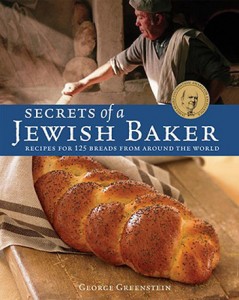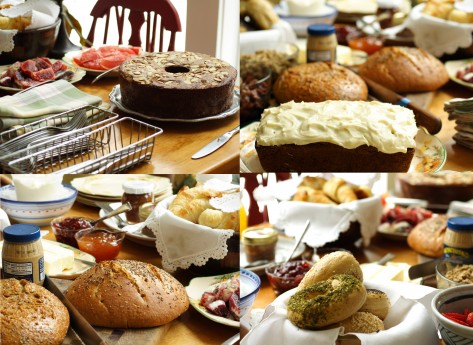Baking with George Greenstein

SECRETS OF A JEWISH BAKER
Recipes for 125 Breads from Around the World
by George Greenstein
Ten Speed Press
328 pp. $29.99
It has been my experience that many excellent cooks and bakers are intimated by the thought of making bread at home. Yet bread baking can be made simple to understand for the both the novice and the experienced baker.
—George Greenstein
Truer words were never said. And they are exactly the sentiments of Sam Heffernan, the member of this club who suggested we do a baking book. She wanted not only to share her love of bread, but also to encourage our club members to bake and to learn for themselves that bread baking is really quite doable. (Which, by the way, is what happened.)
Sam has some baking cred: She’s been baking bread at home for more than forty years. She says her boy never ate store-bought bread (lucky boy). To Sam, bread baking is as routine and necessary as other common domestic tasks. The difference between bread baking and, say, doing the dishes is the former can become a life-long avocation.
A committed bread baker, Sam has devised a way to make homemade bread when she’s staying at her home away from home, a 27-foot Cape Dorey docked in a marina on Lake Champlain in Vermont. Since she has no oven on the boat, she uses a burner and a Dutch oven. The incongruous smell of fresh baked bread wafting across the marina always brings inquisitive people round, like “moths to a flame,” Sam says. She knows first-hand how fundamental a joy, and draw, the smell of fresh baking bread is.
So, when Sam says she thinks Secrets of a Jewish Baker by George Greenstein is a good book that has some weight, in my book. Besides liking all of the recipes she tried from the book, Sam likes that all of her favorite breads are included in this single volume. Instead of trying to remember which bread recipe is in which of her ten baking books, she can turn to Secrets of a Jewish Baker and find them all.
Indeed, despite its title, the number and range of breads in Greenstein’s book is vast. It is by no means limited to traditional Jewish breads, such as ryes, challah, and bagels, though these are included. There are breads from all parts of the world, from Italy, France, India, and Russia to England, the Middle East, America, and beyond.
But what do the club members who had previously done little or no bread baking think of the book? Their success or failure is perhaps an even better gauge.
We, the bread novices (I am counted among them), discovered that bread baking can be done at home, and that nurturing a starter is fun (it’s like having a low-maintenance pet to look after). Most everyone had success with all of the recipes they tried, especially once establishing a rhythm and feel for some of the basics—kneading, forming loaves, baking with steam, and so on.
Here is a list of our favorite breads and baked goods, which includes quick-breads as well as yeasted breads:
Bagels
Cornmeal Bread—a chemically risen corn bread, but with much less cornmeal than most American corn breads.
Rich Cranberry Walnut Muffins
Rich Carrot Loaf—excellent carrot cake with buttery, lemony, cream cheese frosting
Croissants
Laszlo’s Sourdough Potato Rye Bread with Caraway
Jewish Rye
Cocktail Rye
Jewish Corn Bread
Russian Health Bread
San Francisco-Style Sourdough Bread
Sourdough Country Corn Bread
Whole Wheat Sourdough French Bread
Za’atar Bread—Greenstein’s Pita recipe baked with za’atar spice blend and olive oil
And here are some shots of the very delicious spread of baked goods we enjoyed at our potluck for Secrets of a Jewish Baker:

The only complaints with the recipes were omissions or typos. Though the editorial errors are not rampant, it’s clear a better copy editor or proofreader was needed for the Ten Speed Press edition. In the Focaccia recipe, for example, you are instructed to rice cooked potatoes early in the method, but at no point later are you told what to do with the riced potatoes. And sometimes an ingredient like salt, though included in the ingredients list, does not appear in the method. (This is the case for the Jewish Corn Bread recipe; luckily I caught this, but I would have been really bummed if I’d gone to the trouble to make homemade bread and it was bland because of a lack of salt.) Thankfully, such errors are rare.
The only other “problem” was a good problem: an abundance of breads. Most of the club members baking from the book live in a two-person household because a) they haven’t yet had kids, b) they never had kids, or c) their kids are grown up and are out of the house. Many of the recipes yield two loaves, which can be too much bread for two people.
To avoid becoming overwhelmed with bread, or allowing some to get stale, Bhakti Ziek, a DCCC member, came up with a solution to the “problem.” Whenever a recipe makes two loaves, Bhakti freezes the dough for one loaf. She follows the recipe through the point of kneading and forming it into a ball. She then places the ball of dough in a labeled freezer bag and freezes it.
When she wants to bake a loaf of bread, she takes the dough out of the freezer and allows it to defrost slowly in the refrigerator. The next day she punches it down, forms it into the desired final shape, gives it a final proof, and bakes it. She loves this system: She can have fresh bread with very little work, at least half of the time.
The final chapter of Secrets of a Jewish Baker is unique. Called “Twelve Menus: A Morning of Baking,” this chapter includes twelve prioritized baking schedules (called “programs”) that keep you efficiently moving through every step of the baking process. The result is that in the course of a morning, you end up with several loaves of breads, muffins, coffee cakes, or whatever else is included in that particular program.
These programs are little jewels. In them, Greenstein distills his years of professional baking experience to help us, the home bakers, make much better use of our time in the kitchen. Prioritizing time is one of the most critical skills for the professional chef or baker; having a window into how a professional bakes at highly productive levels, translated for the home cook, is a generous gift.
It was Marianne McCann, one of our club members, who pointed out how wonderful the menus are—and not just as exercises in prioritizing baking tasks, but as a fun way to spend a morning with friends or family, baking together.
Looking closer, I realized these programs are where Greenstein’s presence if perhaps most personal, directing our motions in the kitchen, and advising us in Step 6 of the first Morning of Baking, like a concerned father or employer, not to miss our breakfast: “If you waited for breakfast, now is the time to eat the hot muffins you just made, served with assorted spreads.”
And tucked in the eleventh program is a recipe for sourdough pancakes that utilizes some of Greenstein’s rye sour. (Yeah! Yet another use for this fabulous sour.) You mix part of the pancake batter the night before, and complete it the morning of baking, but only after getting the dough for the San Francisco−Style Sourdough Bread started. Then you sit down to a breakfast of pancakes before continuing. On this morning, Greenstein wants to make sure you don’t skip your breakfast.
I am tempted to try one of these programs, just to see how efficient I can become. I am going to wait until late spring, however, when the rising times in the drafty Vermont Victorian I live in will be closer to Greenstein’s estimates. Otherwise, I a “morning” of baking will turn into a “morning, day, and night” of baking.

Ohhh, this was a potluck I knew I didn’t want to miss, and I was right! It all looks fantastic–great photos Holly!
1We missed you! Listen, since you weren’t there, and I did have a chance to ask you what recipes from the book you loved most, chime in here, if you like.
2